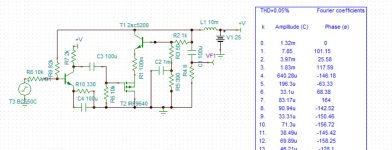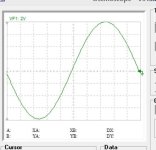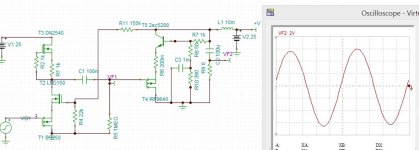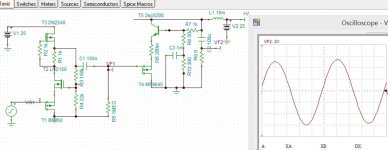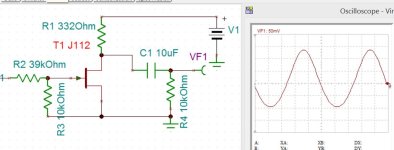That is a source follower, it is needed to linearize it by applying a positive voltage to its gate if needed.the pmos is generating it.
This indeed is one of the points where I need help. I thought about a diode in the bias, fixed to the nmosfet.How your bias gets temperature compensation?
H
HAYK
I don't see any other way than 2 stage with inverting input, with or without feedback.
For temperature drift, use NTC with the floating bias supply for -7mv/°C.
For temperature drift, use NTC with the floating bias supply for -7mv/°C.
It's available under Bordodynov's lib here: http://bordodynov.ltwiki.org/Indeed that would be a LM4562, I simply don't have it on LTSPICE.
It improves performance quite a bit above 1k and noise across the board. The model file doesn't list distortion as modeled explicitly but most other important characteristics are listed. I'm not sure that it would make a difference to performance here if distortion were modeled.
A couple things: I added the series resistance listed in the specs for the choke you listed on post 1 and it increased distortion. And what is your plan for the 9.2V drop?
H
HAYK
H
HAYK
If I add an inverter, the positive input, gets higher than the negative in open loop, nice. In closed loop, it gets back reversed, how strange.
I wonder how George, Tubelab, used it initially.
I wonder how George, Tubelab, used it initially.
Attachments
A 5 kOhm trimmer set as rheostat with a 100 uF capacitor in parallel (plus a poly if needed). It is needed to drop that voltage with the DC current flowing through R1 and R4, but having low AC impedance to let the feedback be correctly applied by the opamp.And what is your plan for the 9.2V drop?
H
HAYK
H
HAYK
@HAYK
@Nelson Pass suggests negative phase 2nd harmonic, not positive ( " from listening tests we learn that there is a tendency to interpret negative phase 2nd as giving a deeper soundstage and improved localization than otherwise. Positive phase seems to put the instruments and vocals closer and a little more in-your-face with enhanced detail. [OMISSIS] Roughly speaking, they tended to prefer about 1% negative phase 2nd harmonic" https://positive-feedback.com/audio-discourse/the-pass-h2-harmonic-generator/ ).
The single stage has negative phase on 2nd harmonic.
Do you have different experience?
@Nelson Pass suggests negative phase 2nd harmonic, not positive ( " from listening tests we learn that there is a tendency to interpret negative phase 2nd as giving a deeper soundstage and improved localization than otherwise. Positive phase seems to put the instruments and vocals closer and a little more in-your-face with enhanced detail. [OMISSIS] Roughly speaking, they tended to prefer about 1% negative phase 2nd harmonic" https://positive-feedback.com/audio-discourse/the-pass-h2-harmonic-generator/ ).
The single stage has negative phase on 2nd harmonic.
Do you have different experience?
H
HAYK
There are two ways to define music, Italian melodic way or French harmonic way.
In the first case you need the interpretation to be the clearest possible to get all the detailed
expressions of the artist. The second on the contrary all expressions should be blunt to let the person enjoy the sound of the instruments while dining or gambling, chambre music as example. If it was painting it should look Turner style.
Personally, I get headache with such sound, as if I am watching unfocused images.
In the first case you need the interpretation to be the clearest possible to get all the detailed
expressions of the artist. The second on the contrary all expressions should be blunt to let the person enjoy the sound of the instruments while dining or gambling, chambre music as example. If it was painting it should look Turner style.
Personally, I get headache with such sound, as if I am watching unfocused images.
Attachments
Like this:A couple things: I added the series resistance listed in the specs for the choke you listed on post 1 and it increased distortion. And what is your plan for the 9.2V drop?
Both mosfets can't be the one you see there, as it will be needed to have a TO220 at least for the pmosfet (low Ciss and Rdson are needed), and a TO247 for the nmosfet (low Rdson and high gm are needed).
It would be great to have some advice on this.
Why did you change the other component values and go to only one FET on top? Also, I attached my file of your original circuit (only changes are to some sim parameters, added .meas commands, and adding LM4562). When removing one of the top FETs in original circuit distortion doubles at 2W/4R (actually slightly less than 2W w/ output impedance). Also wanted to note, on the 20W/8R distortion increase, not sure more feedback or different feedback would help--you just run out of current there with 2A bias.
Attachments
- Home
- Amplifiers
- Solid State
- Single-stage class A 20 wRMS mosfet-amp: can you help me to develop it?
